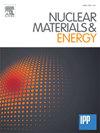锂托卡马克实验中改进的液体锂表面
IF 2.3
2区 物理与天体物理
Q1 NUCLEAR SCIENCE & TECHNOLOGY
引用次数: 0
摘要
在LTX-β连续运行的五年中,真空、表面和锂调节技术的进步已经产生了镜面状的液体锂表面,并证明了完全由液态金属包围的高性能托卡马克放电的可行性,而不会出现重大的操作问题。调理技术和程序的改进,包括数周的烘烤和70克锂的积累,导致了残留气体的减少和锂表面的清洁,同时仍然保持了多次真空诊断升级和校准的足够的操作灵活性。涂层具有明显的清洁外观,具有反射性的液态金属表现出良好的润湿性和表面粘附性,现在宏观上很厚。固化后的锂显示出大的晶粒,而表面科学测量发现锂中的杂质减少了。使用液态锂实现了等离子体性能的稳步提高,在Ip和ne的演变方面,放电能够与固体锂相匹配,包括快速的密度泵送,表明低回收。有迹象表明,锂杂质流入适度增加,尽管在数百次放电中,托卡马克操作很少受到大液体表面的明显干扰。液态金属等离子体表面组件是解决极端高温和粒子通量可能对固体材料造成不可接受的损害的潜在解决方案,而液态锂也有可能在低回收状态下大大增加限制。虽然许多液态金属方法是可能的,并且在聚变装置的试验台和小模块中进行了许多实验,但LTX-β是唯一一个在液态金属完全包围下运行的托卡马克。本文章由计算机程序翻译,如有差异,请以英文原文为准。
Improved liquid lithium surfaces in the Lithium Tokamak Experiment-β
Advances in vacuum, surface, and lithium conditioning techniques throughout five years of continuous operations in LTX-β have produced mirror-like liquid lithium surfaces and demonstrated the feasibility of high-performance tokamak discharges fully surrounded by liquid metal without significant operational problems. Improvements in conditioning techniques and procedures, including many weeks of baking and accumulation of 70 g of Li, led to reduced residual gasses and clean Li surfaces − all while still maintaining enough operational flexibility for multiple in-vacuum diagnostic upgrades and calibrations. Coatings had a visibly clean appearance, with reflective liquid metal demonstrating good wetting and surface adhesion with films that were now macroscopically thick. Solidified Li showed large crystal grains, while surface science measurements observed reduced impurities in the lithium. Steadily improved plasma performance was achieved with liquid lithium, with discharges able to match solid Li in terms of evolution of Ip and ne, including rapid density pumping indicating low recycling. There were indications of moderately increased Li impurity influx, though few significant disturbances by the large liquid surfaces on tokamak operations over hundreds of discharges. Liquid metal plasma facing components are a potential solution to the extreme heat and particle fluxes that could cause unacceptable damage to solid materials, while liquid lithium also has the potential for greatly increased confinement in the low-recycling regime. While many liquid metal approaches are possible, and numerous experiments have been conducted in test stands and small modules in fusion devices, LTX-β is the only tokamak operated while fully surrounded by liquid metal.
求助全文
通过发布文献求助,成功后即可免费获取论文全文。
去求助
来源期刊

Nuclear Materials and Energy
Materials Science-Materials Science (miscellaneous)
CiteScore
3.70
自引率
15.40%
发文量
175
审稿时长
20 weeks
期刊介绍:
The open-access journal Nuclear Materials and Energy is devoted to the growing field of research for material application in the production of nuclear energy. Nuclear Materials and Energy publishes original research articles of up to 6 pages in length.
 求助内容:
求助内容: 应助结果提醒方式:
应助结果提醒方式:


